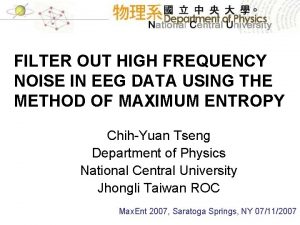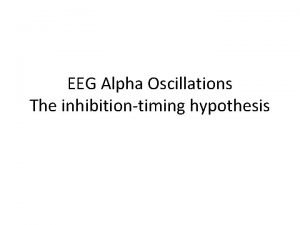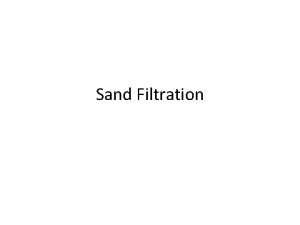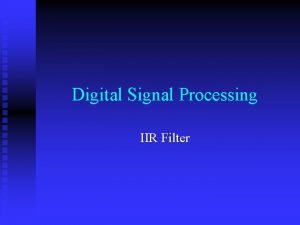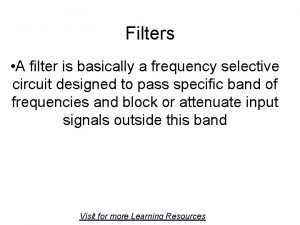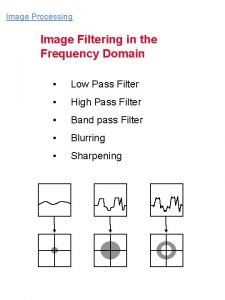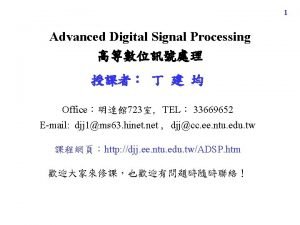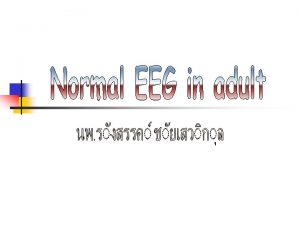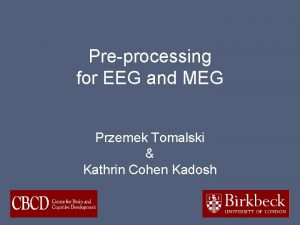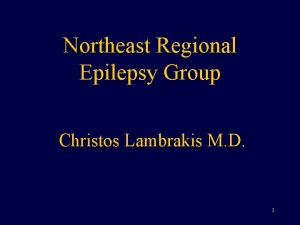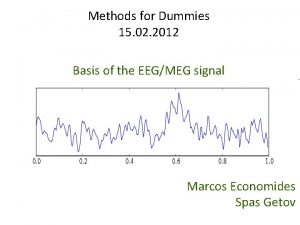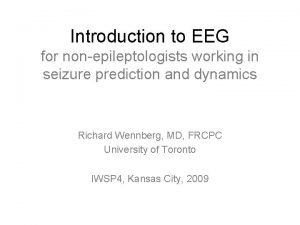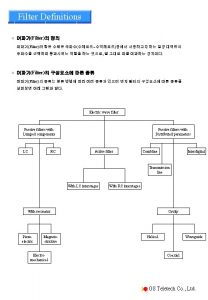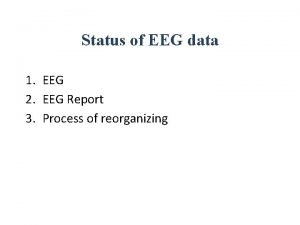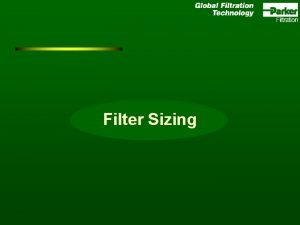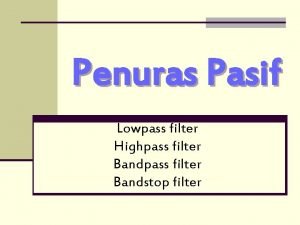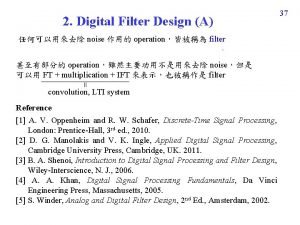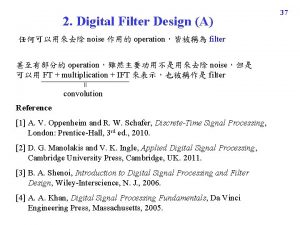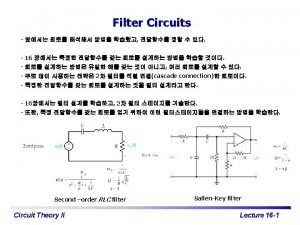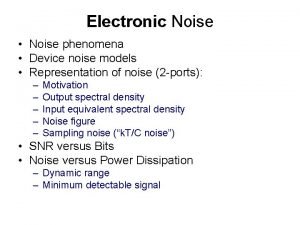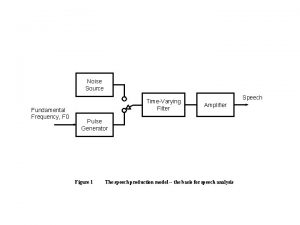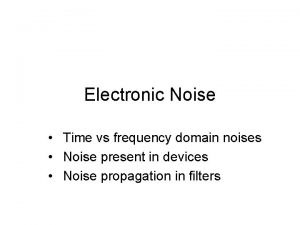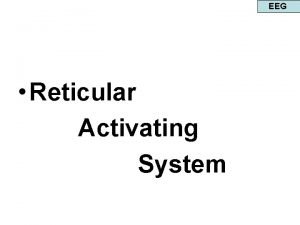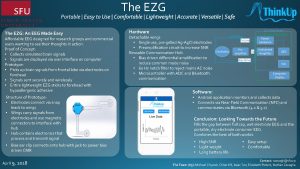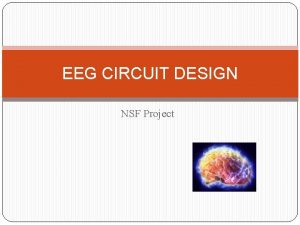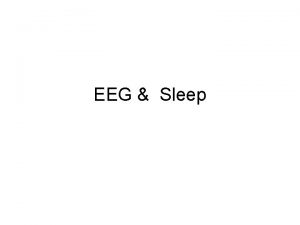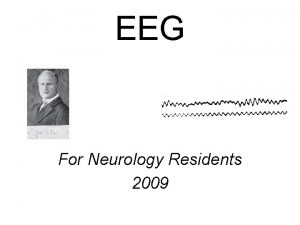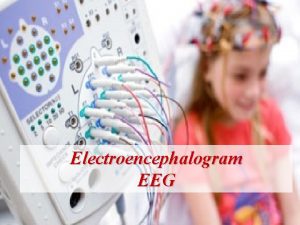FILTER OUT HIGH FREQUENCY NOISE IN EEG DATA























- Slides: 23

FILTER OUT HIGH FREQUENCY NOISE IN EEG DATA USING THE METHOD OF MAXIMUM ENTROPY Chih-Yuan Tseng Department of Physics National Central University Jhongli Taiwan ROC Max. Ent 2007, Saratoga Springs, NY 07/11/2007

Outline • The task – Source localization from neural electric field potentials within cortices • The current source density method – Two drawbacks • Maximum entropy approach for de-noise • Performance analysis • Conclusion

The task • Cerebral cortex (grey matter) – Physiologically, it can be classified into six layers – Information processing center

• Neural electric field potential – Current source: Ionic currents flow from intracellular into extracellular. – Current sink: vice versa

• The invasive EEG Records intracellular electric field potentials within six layers • Question: – How does one infer current sources and sinks of the electric field potentials from EEG measurements that allows one to study information processing within neurons?

The current source density method • Localizing current source and sink from the field potential analysis – In 1975, Freeman and Nicholson proposed a current source density (CSD) method, which becomes a standard tool in neuroscience until now.

• Basic idea – According to continuity equation and Ohm’s law Field potential Current source and sink – Suppose electric conductivity is isotropic and homogeneous in cortices

• Approximated calculation for current source and sink from a set of discrete data – Second order derivative – Finite difference formula – Smoothing high frequency noise via non-recursive filter

• Some smoothing functions MFS 3 0. 33 0 0 FNS 3(1 0. 5 0. 25 0 0 ) FNS 3(2 0. 43 0. 29 0 0 )RS 0. 54 0. 23 0 0 3 FNS 5 0. 34 0. 24 0. 09 0 FNS 7 0. 26 0. 21 0. 12 0. 04 – Approximated calculation For example, FNS 5 is obtained by substituting this set (3/10, 4/10, 3/10) into the same set (3/10, 4/10, 3/10)

• Two drawbacks – Second order derivative calculation via Ta 3(r) is a gross approximation. – Introduction of some ad hoc empirical guidance to reduce noise in data and noise amplified by operation of the Ta 3(r) • How does one raise accuracy of second order derivative calculation and keep noise small in the meantime? • Are these smoothing functions good enough for EEG analysis? • Is there a systematic and objective approach without introducing ad hoc rules for developing smoothing functions?

Maximum entropy approach for denoise • The method of maximum entropy: Tool for assigning probability distribution – What kind of information is relevant to the system? i. e. What are constraints? • Basic idea for smoothing high frequency noise using the method of maximum entropy – What kind of information we need to know for denoise in EEG studies? 1. pl is symmetric around l=0,

2. Additional information

– The preferred pl Maximizing entropy subject to constraints

– In principle, the Lagrangian multiplier can be determined if expectation value d 2 is given Unfortunately, we have no information regarding d 2 – A solution: Minimizing noise variance For a noise

Variance of smoothed field potentials The preferred a value is 0 Is this smoothing function good enough for our purpose?

Variance of second order derivative with smoothed field potentials

• Smoothing noise amplified in operation of second order derivative calculation – Minimizing variance of second order derivative with smoothed field potentials MES 3 Ta 3 0. 42 0. 28 0 0 MES 5 Ta 3 0. 29 0. 23 0. 12 0 MES 7 Ta 3 0. 22 0. 19 0. 12 0. 06

Performance analysis • Frequency analysis – For smoothing function, the transfer function: Suppose and substitute into

– For second order derivative with smoothed data, the transfer function is given by

• Noise analysis – Variance analysis – K-value analysis CDS 2(Xs 2 ) K MFS 3 Ta 3 0. 44 1. 33 FNS 3 Ta 3(1) 0. 38 1. 01 FNS 3 Ta 3 (2) 0. 28 1. 13 RS 3 Ta 3 0. 57 1. 34 MES 3 Ta 3 0. 28 1. 14 FNS 5 Ta 3 0. 073 0. 63 MES 5 Ta 3 0. 048 0. 48 FNS 7 Ta 3 0. 019 0. 39 MES 7 Ta 3 0. 014 0. 27

Conclusions • We propose a maximum entropy approach to smooth noise in EEG studies without introducing any ad hoc rules • Two analyses shows the proposed ME smoothing functions to outperform conventional designs • One can easily extend the ME smoothing function for cases other than EEG studies with relevant information.

Acknowledgment: This work is partially supported by National Science Council, Taiwan, ROC.

Thanks for your attention!!
 High frequency filter eeg
High frequency filter eeg Eeg bands
Eeg bands Noise
Noise Perbedaan rapid sand filter dan slow sand filter
Perbedaan rapid sand filter dan slow sand filter Iir filter design by approximation of derivatives
Iir filter design by approximation of derivatives Residual chlorine
Residual chlorine One direction song one thing
One direction song one thing Frequency selective circuit
Frequency selective circuit What is conditional relative frequency
What is conditional relative frequency How to calculate relative frequency
How to calculate relative frequency Form factor formula
Form factor formula Vmax = aw
Vmax = aw Frequency vs relative frequency
Frequency vs relative frequency Marginal frequency distribution
Marginal frequency distribution Marginal frequency
Marginal frequency High pass filter radiology
High pass filter radiology High pass filter matlab
High pass filter matlab 高等數位訊號處理 丁建均
高等數位訊號處理 丁建均 Band pass filter aktif
Band pass filter aktif K complexes eeg
K complexes eeg Eeg sweat artifact
Eeg sweat artifact Xl spikes on eeg
Xl spikes on eeg Eeg for dummies
Eeg for dummies Lateral rectus spikes eeg
Lateral rectus spikes eeg
